Looking for a pineapple sauce for fish that’ll transform your seafood dinner? This tropical delight might just become your new secret weapon in the kitchen.
Transform your ordinary fish dinner into a tropical vacation with this vibrant pineapple sauce. The sweet-tangy flavor of fresh pineapple perfectly complements delicate fish fillets, creating a harmonious balance that’ll make your taste buds dance. Whether you’re serving up grilled mahi-mahi, pan-seared salmon, or baked tilapia, this versatile sauce adds just the right amount of island-inspired zing.
You’ll love how quickly this sauce comes together – in just minutes, you’ll have a restaurant-quality topping that elevates even the simplest fish dishes. The natural sweetness of pineapple pairs with savory elements to create a complex flavor profile that makes everyday meals feel special. It’s the perfect way to bring a taste of the tropics to your dinner table any night of the week.
What Makes Pineapple Sauce Perfect for Fish
Pineapple sauce creates a harmonious flavor partnership with fish thanks to its unique combination of sweetness and acidity. The natural sugars in pineapple caramelize slightly during cooking which enhances the delicate flavors of most fish varieties without overpowering them.
The tropical fruit contains bromelain—an enzyme that naturally tenderizes proteins—making your fish fillets even more succulent when paired together. This enzymatic action works particularly well with firmer fish like mahi-mahi and swordfish.
Nutritionally speaking pineapple brings vitamin C and manganese to your seafood dish creating a more balanced meal. The bright citrus notes cut through the richness of fattier fish like salmon while complementing leaner options such as cod or tilapia.
The versatility of pineapple sauce allows it to work with virtually any cooking method—whether you’re grilling baking or pan-searing your fish. The sauce creates a beautiful glaze when reduced slightly giving your dish an appealing restaurant-quality finish.
Fish often benefits from acidic companions and pineapple provides this acidity in a naturally sweet package eliminating the need for additional sweeteners. The texture contrast between tender fish and the slight chunkiness of a well-made pineapple sauce adds another dimension to your dining experience.
Unlike heavy cream-based sauces pineapple sauce offers a lighter alternative that won’t mask the delicate flavor of your seafood. The vibrant yellow color adds visual appeal to your plate making the dish as beautiful as it is delicious.
Ingredients You’ll Need

Creating the perfect pineapple sauce for fish requires a balance of sweet, tangy, and savory elements. Gather these essential ingredients to create a sauce that will elevate your seafood dish from ordinary to extraordinary.
- Fish fillets: White fish varieties like cod, haddock, tilapia, orange roughy, or halibut work beautifully; salmon is also an excellent choice
- Pineapple: Either fresh chunks or canned pineapple with juice
- Aromatics: Onions, bell peppers, garlic, and fresh ginger
- Liquid components: Pineapple juice, lime or orange juice for brightness
- Savory elements: Soy sauce for depth of flavor
- Sweeteners: Honey or a touch of ketchup for balance
- Acid: White vinegar to enhance tanginess
- Thickener: Cornstarch mixed with cold water or juice
- Fresh herbs: Tarragon, parsley, or cilantro for garnish
- Spices: Garlic powder, ground ginger, and black pepper
Fresh vs. Canned Pineapple
Fresh pineapple delivers a vibrant, bright flavor profile and maintains a firmer texture in your sauce. The natural juices provide an authentic tropical taste that feels lighter and more refreshing when paired with delicate fish. You’ll notice a more complex flavor when using fresh pineapple, with subtle notes that canned varieties sometimes lack.
Canned pineapple offers convenience and consistency that many home cooks appreciate. The juice comes ready to use as a liquid base for your sauce, eliminating the need for additional preparation. Canned varieties tend to be sweeter and softer, which allows them to incorporate more easily into a smooth sauce. Both options work wonderfully in this recipe, so choose based on what’s available and your personal preference for texture and sweetness level.
Herbs and Spices
Aromatic foundations begin with freshly minced garlic and ginger, which should be sautéed until fragrant before adding your pineapple components. These aromatics create a savory base that balances the natural sweetness of the fruit.
Green onions or scallions contribute a mild, fresh onion flavor without overpowering the delicate fish. Reserve some for garnishing your finished dish to add a pop of color and freshness.
Fresh herbs introduce brightness and complexity to your pineapple sauce. Tarragon pairs exceptionally well with fish and adds a subtle anise-like note, while cilantro brings a citrusy quality that complements the pineapple. Parsley offers a clean, verdant finish that works with virtually any fish variety.
Warming spices like curry powder can transform your sauce into something more complex and aromatic. For those who enjoy heat, finely diced jalapeños or a pinch of crushed red pepper flakes create a pleasant contrast to the sweet pineapple. Ground ginger amplifies the fresh ginger flavor, creating deeper dimension throughout your sauce.
Cornstarch serves as the perfect thickening agent for pineapple sauce. When mixed with cold liquid and added to the simmering sauce, it creates a glossy finish that beautifully coats your fish fillets. This silky texture ensures the sauce clings to each bite rather than pooling on the plate.
Equipment Needed
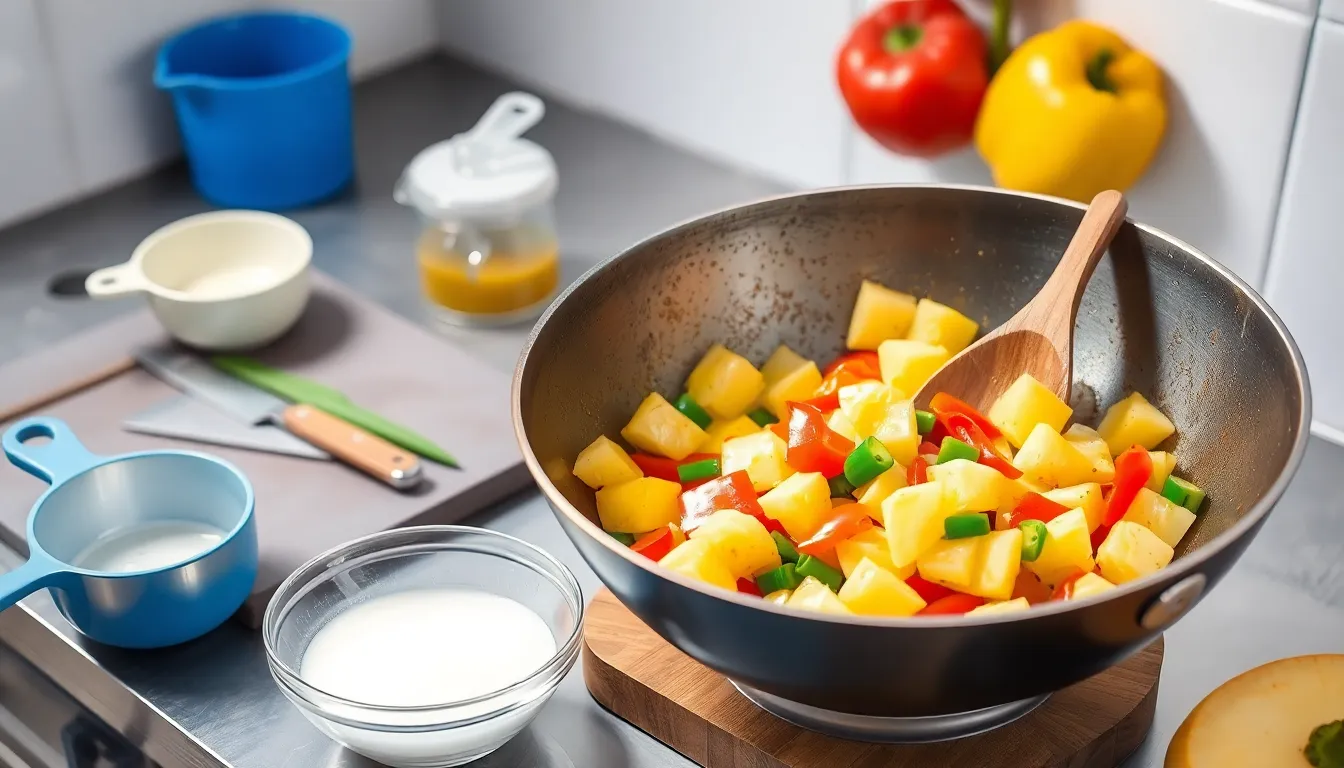
Creating the perfect pineapple sauce for fish requires minimal yet exact kitchen tools to ensure smooth preparation. Gather these essential items before starting your culinary adventure:
- Wok or wide deep pan – Provides ample space for sautéing aromatics and combining sauce ingredients without spillover
- Spider ladle – Essential for carefully lifting and handling fried fish or sautéed vegetables while maintaining their shape and texture
- Wooden spoon or cooking spatula – Allows gentle stirring of the sauce without scratching your cookware
- Knife and cutting board – Necessary for properly dicing pineapple chunks and preparing vegetables like bell peppers, carrots, and onions
- Cast iron skillet or non-stick pan – Ideal for achieving that perfect crispy exterior when frying fish fillets before adding sauce
- Small bowl – Useful for creating cornstarch slurry to thicken your pineapple sauce to the perfect consistency
- Measuring cups and spoons – Ensures proper proportions of ingredients like soy sauce, oyster sauce, and honey for balanced flavor
Your sauce will develop complex flavors as aromatics sauté and pineapple juices reduce. The proper equipment makes this process effortless while ensuring restaurant-quality results every time. A good wok particularly excels at quick reduction of pineapple juices while providing enough surface area to layer flavors effectively.
How to Make Pineapple Sauce for Fish
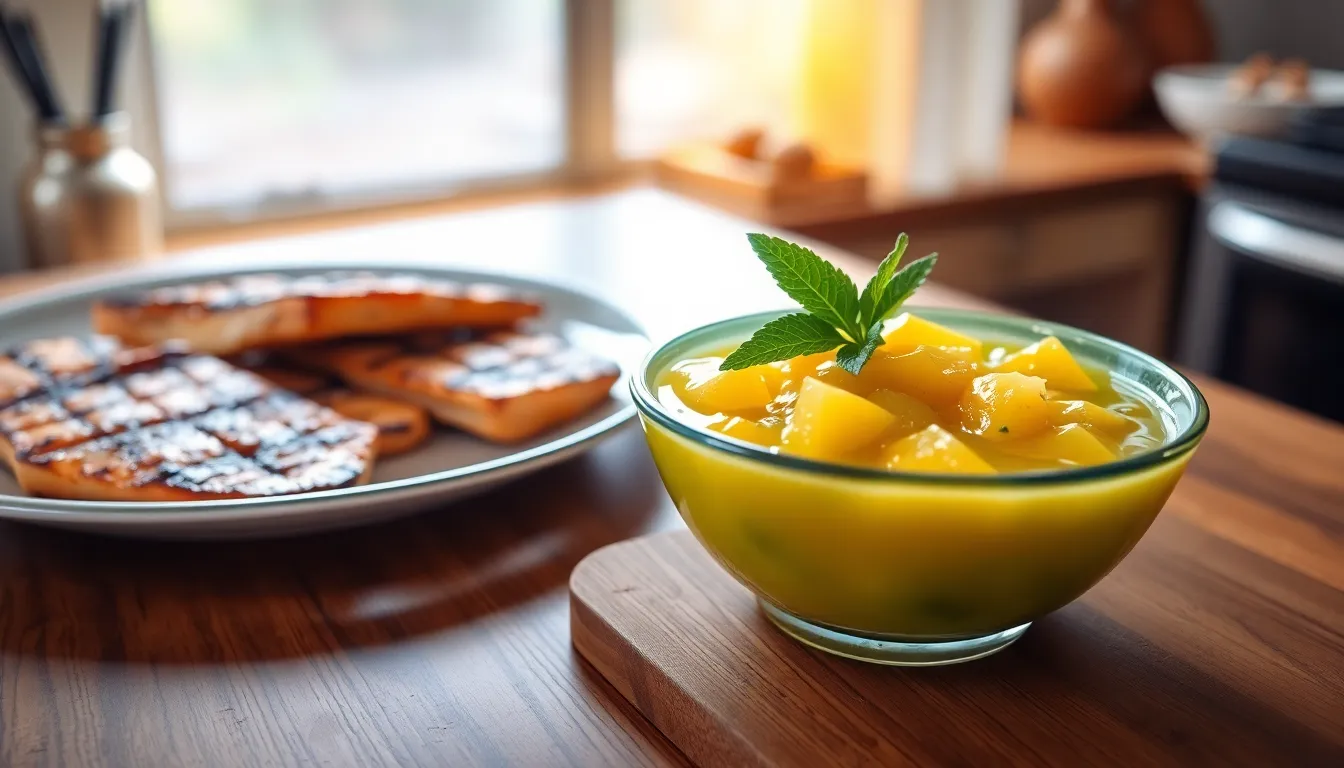
Creating this vibrant sauce is simpler than you might think and will elevate your fish dishes with tropical flair. Follow these steps to prepare a delicious pineapple sauce that perfectly complements your seafood.
Preparing the Pineapple
Start with selecting the right pineapple for your sauce. Choose a ripe pineapple that yields slightly to pressure and has a sweet aroma at the base. Peel the pineapple completely and remove the tough core before chopping it into small cubes for the best texture. If you’re short on time, canned or pre-cut pineapple works as a convenient alternative. When using canned pineapple, drain and rinse the chunks to reduce excess syrup that might make your sauce too sweet. For a smoother consistency, place your pineapple chunks in a food processor or blender and pulse until coarsely chopped but not completely puréed—this maintains some texture while releasing the fruit’s juices.
Cooking the Sauce
Transfer your prepared pineapple to a heavy-bottomed pan to prevent scorching. Add aromatics to build flavor depth—minced garlic, freshly grated ginger, or finely diced shallots work wonderfully as a flavor base. Pour in your choice of liquid to add brightness; options include orange juice, pineapple juice, lemon juice, rice vinegar, or apple cider vinegar depending on your desired flavor profile. Incorporate sweeteners like brown sugar or honey to balance the acidity and enhance caramelization. Spices add complexity—try red pepper flakes for heat or curry powder for warmth and depth.
Set your pan over medium heat and bring the mixture to a gentle simmer. Stir occasionally to prevent sticking and cook for 6-10 minutes until the flavors meld together and the liquid reduces slightly. The sauce will become more concentrated as it cooks, intensifying the tropical flavors. You might consider adding fresh mint leaves or diced jalapeños during the last few minutes of cooking for additional layers of flavor.
Adjusting the Consistency
Create a cornstarch slurry by mixing 1-2 teaspoons of cornstarch with an equal amount of cold water in a small bowl until smooth. Pour this mixture into your simmering sauce during the final minutes of cooking while stirring constantly to prevent lumps from forming. The sauce will thicken noticeably as it continues to simmer. Keep cooking until your sauce reaches your preferred consistency—it should coat the back of a spoon but still pour easily.
Remove the pan from heat once you’ve achieved the desired thickness and allow the sauce to cool slightly before serving. Pour your completed pineapple sauce directly over freshly cooked fish fillets just before serving. This sauce pairs exceptionally well with fish that has been grilled, pan-fried, or baked until just cooked through. Garnish with freshly chopped herbs like parsley or sliced green onions for a professional finishing touch and additional flavor contrast. Any leftover sauce can be refrigerated in an airtight container for up to one week.
Best Fish to Pair With Pineapple Sauce
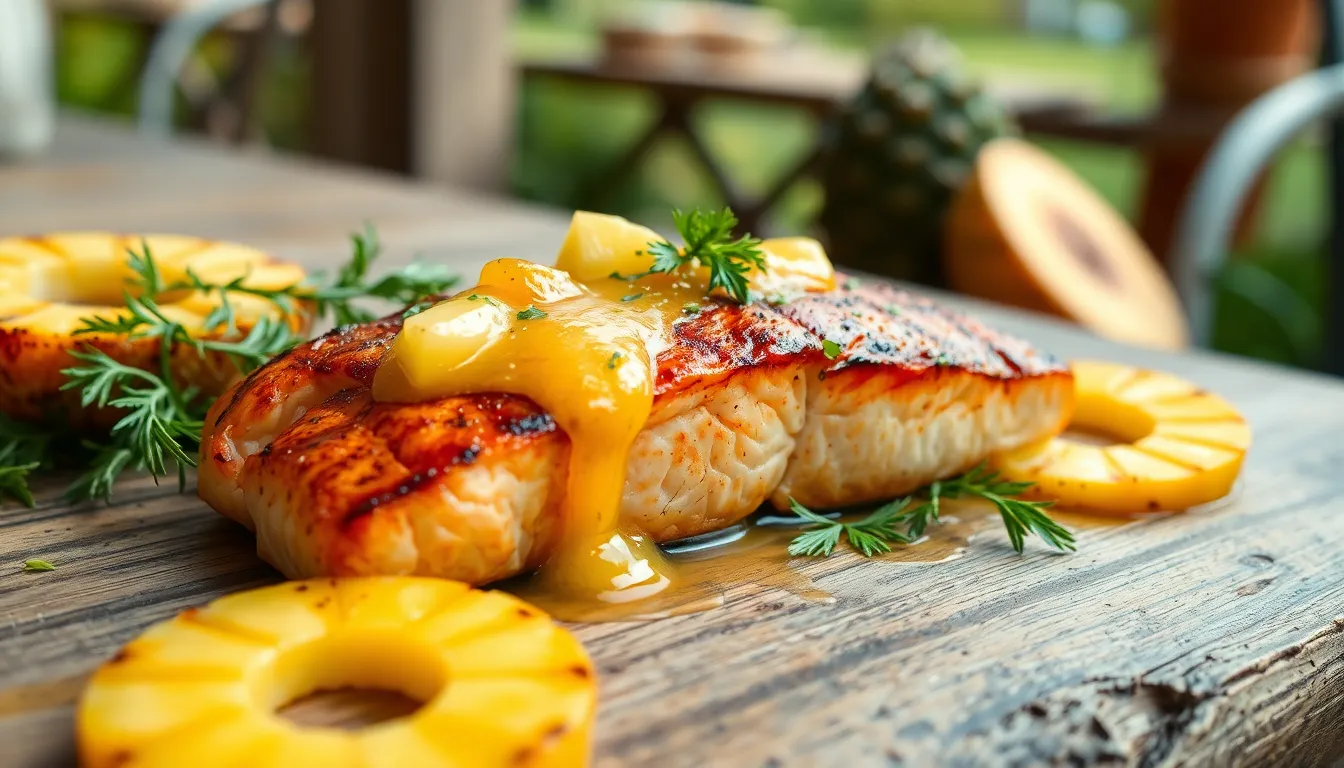
Selecting the right fish for your pineapple sauce can transform an ordinary meal into a memorable dining experience. The sweet tanginess of pineapple creates a perfect flavor counterpoint to these seafood options.
White Fish Options
White fish varieties offer the perfect canvas for vibrant pineapple sauce due to their mild flavor profiles. Tilapia stands out as an affordable and accessible option that readily absorbs the sweet and tangy notes of pineapple. This budget-friendly fish cooks quickly and works beautifully when pan-fried and topped with pineapple cream sauce. Cod and haddock provide excellent alternatives with their flaky texture and subtle flavor that won’t compete with your sauce. These versatile fillets can be found fresh or frozen in most markets, making them convenient choices for weeknight meals. Halibut offers a more premium option with its firm texture that holds up wonderfully under the weight of a rich pineapple sauce. Red snapper deserves special attention for its slightly sweet flavor that naturally complements the tropical profile of pineapple. The firm texture of snapper maintains its integrity even when covered with sauce, ensuring every bite delivers the perfect balance of fish and fruity topping.
Grilled Fish Recommendations
Grilling adds a smoky dimension that pairs exceptionally well with sweet pineapple sauce. Salmon, though not a white fish, creates a magnificent flavor combination when grilled and finished with warm pineapple sauce. The rich, fatty nature of salmon stands up beautifully to the acidic punch of pineapple, creating a balanced bite. Mahi mahi ranks among the top choices for grilling with pineapple accompaniments, as its firm, meaty texture holds up well on the grill while complementing the tropical sauce notes. You might also consider swordfish for its steak-like quality that maintains structure on the grill and provides a substantial base for a generous serving of pineapple sauce. Pompano works wonderfully for those seeking a grilled option with a more delicate flavor profile, especially in Caribbean-inspired recipes. The natural smokiness from grilling these fish varieties creates a delightful contrast with the sweet and tangy pineapple sauce, elevating your seafood dinner to restaurant quality with minimal effort.
Serving Suggestions
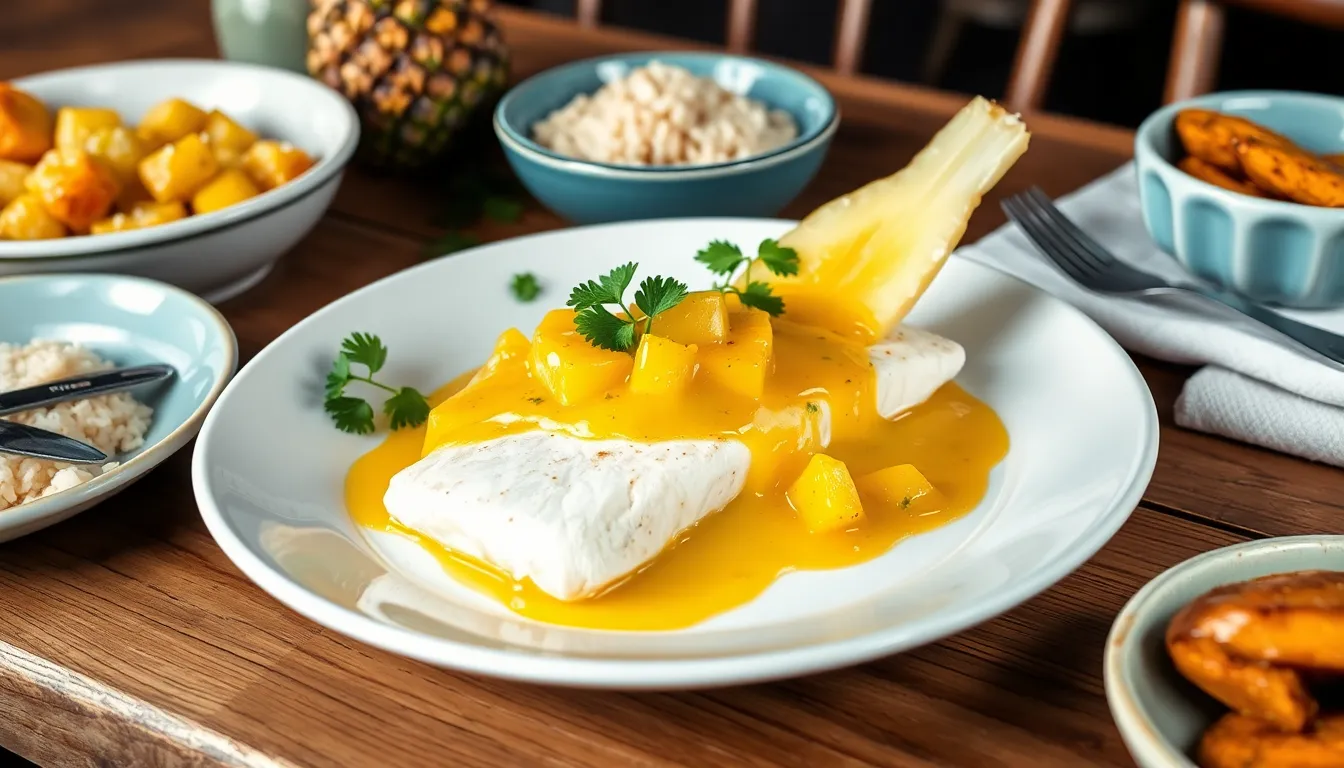
Transform your fish dinner into a complete culinary experience with these perfect pairing ideas for pineapple sauce. The tropical flavor profile opens up many possibilities for creating a balanced and impressive meal.
Main Dish Presentation
Spoon your pineapple sauce directly over freshly cooked fish for an elegant presentation. The vibrant yellow sauce creates a striking contrast against white fish varieties like tilapia or cod. For a restaurant-style plating technique drizzle the sauce around the fish rather than completely covering it allowing the perfectly cooked texture to remain visible. Garnish with a small wedge of fresh pineapple and a sprig of cilantro to signal the flavor profile before the first bite.
Complementary Side Dishes
Pair your pineapple-sauced fish with sides that enhance its tropical theme:
- Coconut rice absorbs the extra sauce while adding creamy texture
- Cilantro lime rice provides bright herbaceous notes that complement the sweet sauce
- Steamed vegetables like bok choy or broccoli balance the dish with freshness
- Roasted sweet potatoes offer a complementary sweetness with added depth
- Black bean and corn salad introduces contrasting textures and flavors
The starchy sides work particularly well as they soak up the delicious sauce that might otherwise be left on the plate.
Serving Styles for Different Occasions
Adapt your serving style based on the occasion:
For casual family dinners serve the fish and sauce in shallow bowls over rice allowing everyone to enjoy the flavorful sauce-soaked grains.
During elegant dinner parties portion individual fillets onto warmed plates with the sauce artfully applied and sides strategically placed for visual impact.
For buffet-style gatherings offer the sauce in a small serving bowl alongside a platter of fish fillets allowing guests to add their preferred amount.
Beverage Pairings
Complete your meal with beverages that complement the sweet-tangy profile of pineapple sauce:
- Crisp white wines like Pinot Grigio or Sauvignon Blanc cut through the richness
- Tropical cocktails featuring pineapple maintain the theme
- Coconut water provides a refreshing non-alcoholic option
- Iced green tea with a hint of ginger balances the sweetness
The right beverage enhances the overall dining experience by highlighting the sauce’s complex flavor notes.
Make-Ahead and Storage Tips
Prepare your pineapple sauce up to 3 days ahead for convenience. Simply reheat gently before serving adding a splash of water or pineapple juice if it has thickened too much in storage. For an impressive yet effortless weeknight dinner prepare all components in advance allowing you to assemble a restaurant-quality meal in minutes.
Storing and Make-Ahead Tips

Preparing pineapple sauce ahead of time can be a game-changer for busy weeknights when you want restaurant-quality fish without the last-minute rush. Your sauce will maintain its vibrant flavors when properly stored, giving you flexibility with meal planning.
Make-Ahead Options
You can prepare the pineapple sauce up to 3-4 days before serving, making it perfect for meal prep. Simply cook the sauce completely according to the recipe, then allow it to cool to room temperature before transferring to an airtight container. Store in the refrigerator until you’re ready to use it with freshly cooked fish. When you’re ready to serve, gently reheat the sauce in a saucepan over medium-low heat until warmed through.
For dinner parties, having the sauce ready in advance allows you to focus on perfectly cooking your fish while still impressing guests with complex flavors. The sauce actually benefits from time to develop as the ingredients meld together during storage.
Proper Storage Techniques
Store leftover pineapple sauce in a glass or plastic airtight container to maintain freshness and prevent absorption of other food odors. Glass containers work particularly well as they don’t absorb colors or flavors from the sauce.
If you’ve already combined the sauce with cooked fish, refrigerate leftovers promptly within two hours of cooking. When reheating, add a sprinkle of water to maintain moisture levels in both the sauce and fish. Microwaving for 1-2 minutes provides gentle reheating that won’t overcook your delicate fish fillets.
Freezing Guidelines
While fresh is always best, you can freeze pineapple sauce for longer storage:
- Cool the sauce completely before transferring to freezer-safe containers
- Leave about ½ inch of headspace to allow for expansion
- Label containers with the date and contents
- Freeze for up to 2 months for optimal quality
Thaw frozen sauce overnight in the refrigerator before gently reheating on the stovetop. You may need to re-thicken with a small amount of cornstarch slurry if separation occurs during freezing.
Time-Saving Tips
For ultimate convenience, prepare multiple batches of pineapple sauce and portion them into smaller containers. This approach allows you to quickly transform ordinary fish dinners into special meals any night of the week.
Slow cooker methods offer another time-saving approach, allowing you to combine sauce ingredients and fish in the morning for a complete meal that’s ready by dinner time. The low, slow cooking process infuses the fish with tropical pineapple flavors while requiring minimal active preparation time.
Recipe Variations
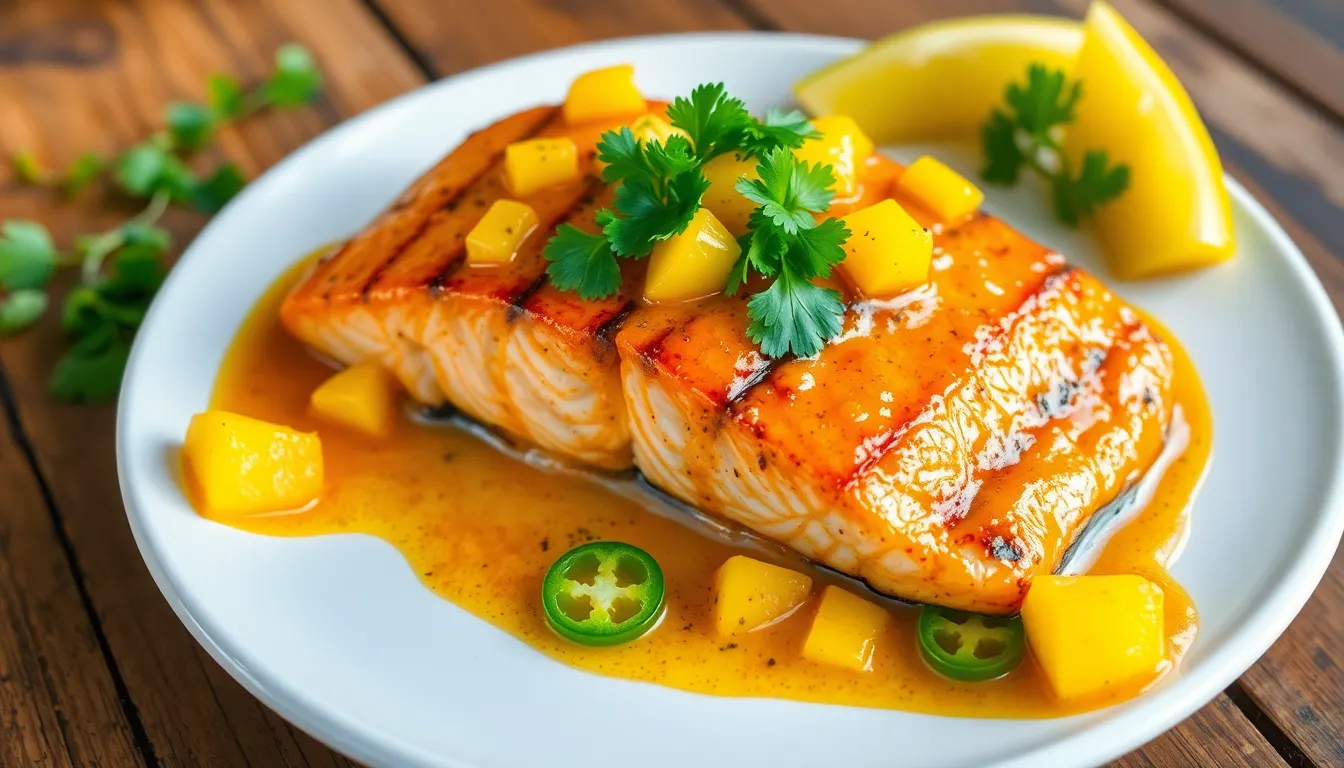
While the classic pineapple sauce delivers exceptional flavor with seafood, these creative variations will add exciting new dimensions to your fish dishes. Each adaptation maintains the foundation of sweet-tangy pineapple while introducing complementary flavors to suit different palates and occasions.
Spicy Pineapple Sauce
Transform your traditional pineapple sauce into a fiery delight by incorporating heat elements that balance perfectly with the natural sweetness. For an impressive spicy version, add 1-2 finely diced jalapeños (seeds removed for milder heat or included for extra kick) to your base sauce during the simmering stage. Fresh ginger increases complexity while cayenne pepper or red pepper flakes provide consistent heat throughout the sauce. Try this robust combination with grilled salmon fillets:
- 1 cup diced fresh pineapple
- 1 jalapeño, finely diced
- 2 tablespoons minced shallots
- 1 tablespoon grated fresh ginger
- ¼ cup orange juice
- 1 teaspoon curry powder
- Pinch of cayenne pepper
The spicy version works exceptionally well with heartier fish varieties like salmon and mahi-mahi that can stand up to bold flavors. For a Cajun-inspired approach, season your fish with a blend of paprika, garlic powder and cayenne before cooking, then top with the spicy pineapple sauce for a remarkable flavor contrast that elevates everyday fish to restaurant quality.
Coconut Pineapple Sauce
Adding coconut milk creates a luxuriously creamy tropical sauce that pairs beautifully with delicate white fish varieties. The richness of coconut balances the tangy pineapple while creating a velvety texture that clings perfectly to each fillet. Prepare this indulgent variation by incorporating ½ cup of coconut milk into your basic pineapple sauce recipe during the final minutes of cooking.
- 1 cup pineapple chunks or crushed pineapple
- ½ cup coconut milk (full-fat provides the best texture)
- 1 tablespoon minced garlic
- 1 tablespoon grated ginger
- 1 tablespoon lime juice
- 1 teaspoon brown sugar
- Fresh cilantro for garnish
The coconut version works beautifully with pan-fried tilapia, cod, or halibut. Simmer the sauce until it reaches a silky consistency that coats the back of a spoon. This variation brings a distinctly tropical character to your seafood dinner, transporting your taste buds to coastal destinations with each bite. Serve this creamy pineapple coconut sauce over fish that has been simply seasoned with salt and pepper to allow the sauce’s complex flavors to shine.
Nutritional Benefits
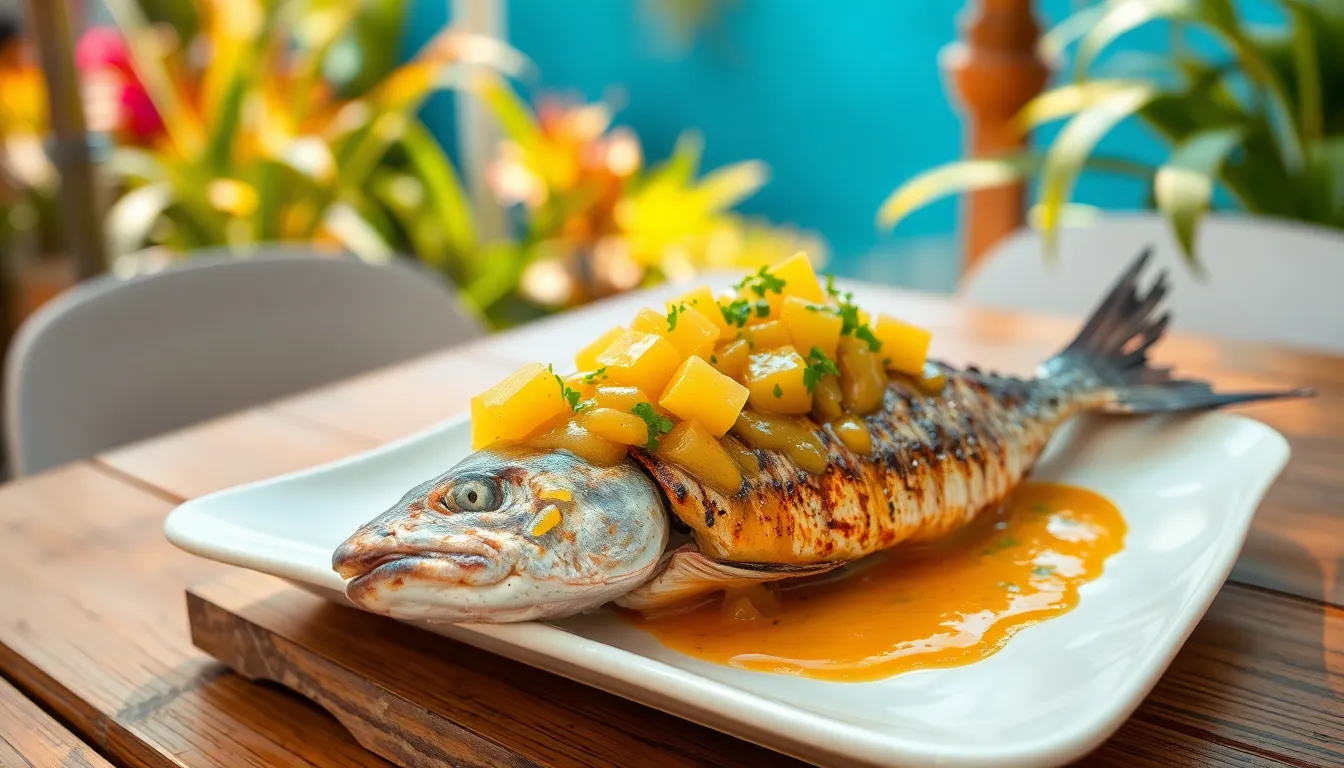
When you pair fish with pineapple sauce you create a meal that delivers impressive nutritional value along with its tropical flavors. This combination brings together lean protein from fish with the vitamin-rich profile of pineapple for a truly balanced dish.
Fish provides high-quality protein and essential omega-3 fatty acids which support brain and heart health. A typical serving of fish with pineapple sauce contains approximately 335 calories with an ideal macronutrient distribution of 32% protein 52% fat and 16% carbohydrates.
The pineapple sauce itself offers substantial nutritional benefits while adding minimal calories. An 80g serving of pineapple contains just 33 calories yet delivers:
- 8.1g carbohydrates
- 1.3g fiber
- 10mg vitamin C
- 128mg potassium
- 0.3g protein
- 0.2g fat
Pineapple brings powerful antioxidants to your plate including bromelain and vitamin C which help combat oxidative stress and support immune function. These compounds work to protect your cells from damage while reducing inflammation throughout your body.
The enzyme bromelain deserves special attention as it not only tenderizes your fish but also supports healthy digestion. This natural enzyme breaks down proteins making nutrients more bioavailable and easier for your body to absorb.
Your cardiovascular system benefits from this pairing too. The omega-3 fatty acids in fish combined with the potassium and vitamin C in pineapple create a heart-healthy meal that supports proper blood pressure and circulation.
| Nutrient Component | Primary Benefit |
|---|---|
| Omega-3 fatty acids (fish) | Brain and heart health support |
| Bromelain (pineapple) | Anti-inflammatory and digestive aid |
| Vitamin C (pineapple) | Immune support and collagen production |
| Potassium (pineapple) | Electrolyte balance and heart function |
| Fiber (pineapple) | Digestive health and satiety |
The pineapple sauce serves as a lighter alternative to cream-based fish toppings while still providing rich flavor. This makes it an excellent choice for those watching their caloric intake or seeking more nutrient-dense meal options.
Elevate Your Seafood Dinner With Homemade Pineapple Sauce
This vibrant pineapple sauce transforms ordinary fish into an extraordinary culinary experience with minimal effort. Whether you’re using fresh pineapple for maximum flavor or canned for convenience you’ll create a sauce that perfectly balances sweetness and acidity.
Remember that this versatile topping works beautifully with delicate white fish fillets and heartier options like salmon or mahi-mahi. The natural enzymes tenderize while the fruity notes enhance without overwhelming.
Next time you’re looking to impress dinner guests or simply want to elevate your weeknight meal try this tropical-inspired sauce. It’s proof that sometimes the simplest additions make the most important difference turning an everyday fish dinner into something truly special and memorable.
Frequently Asked Questions
What makes pineapple sauce good for fish?
Pineapple sauce complements fish perfectly because its sweet-tangy flavor balances with the delicate taste of seafood. The natural sugars in pineapple caramelize during cooking, enhancing fish flavors without overpowering them. Additionally, pineapple contains bromelain, an enzyme that naturally tenderizes proteins, making fish even more succulent. The sauce provides a lighter alternative to cream-based options while adding vibrant color and nutritional benefits like vitamin C and manganese.
Can I use canned pineapple instead of fresh?
Yes, you can use canned pineapple as a convenient alternative to fresh. Canned pineapple offers consistency and is available year-round. Choose pineapple in juice rather than syrup for better flavor control. While fresh pineapple provides more vibrant flavor and firmer texture, canned pineapple works perfectly in this sauce and saves preparation time. Just drain excess liquid before using, as canned pineapple typically contains more moisture.
Which fish varieties work best with pineapple sauce?
Mild white fish like tilapia, cod, haddock, halibut, and red snapper pair beautifully with pineapple sauce as they allow the sauce’s flavors to shine. For grilling, heartier fish like salmon, mahi-mahi, swordfish, and pompano work exceptionally well, as the smoky char complements the sweet-tangy sauce. The sauce’s versatility means it enhances both delicate white fish fillets and richer, meatier seafood options.
How long does homemade pineapple sauce last?
Homemade pineapple sauce keeps well in an airtight container in the refrigerator for up to one week. For longer storage, you can freeze the sauce in ice cube trays or freezer-safe containers for up to 3 months. Allow frozen sauce to thaw overnight in the refrigerator before reheating. The sauce may need a quick simmer and possibly additional cornstarch slurry to restore its consistency after refrigeration or freezing.
Can I make the sauce ahead of time?
Absolutely! Pineapple sauce can be prepared 3-4 days in advance and stored in the refrigerator. This makes it perfect for meal prep or entertaining. The flavors actually develop and improve after a day of melding together. Simply reheat the sauce gently on the stovetop before serving, adding a splash of water or juice if it’s thickened too much during storage. This time-saving approach delivers restaurant-quality results with minimal last-minute effort.
How do I thicken pineapple sauce if it’s too runny?
To thicken runny pineapple sauce, create a cornstarch slurry by mixing 1 tablespoon cornstarch with 2 tablespoons cold water until smooth. Bring your sauce to a simmer, then slowly whisk in the slurry and cook for 1-2 minutes until thickened. Add more slurry if needed, but introduce it gradually to avoid over-thickening. Alternatively, you can continue simmering the sauce to reduce and concentrate the flavors naturally.
Can I make the pineapple sauce spicy?
Yes, you can easily create a spicy variation by adding heat elements to the basic recipe. Incorporate finely diced jalapeños, a dash of red pepper flakes, or a teaspoon of sriracha sauce while sautéing the aromatics. Fresh ginger adds both heat and complexity. For controllable spice levels, add small amounts incrementally and taste as you go. The sweet-spicy combination creates an exciting flavor profile that works particularly well with heartier fish varieties.
What side dishes pair well with fish in pineapple sauce?
Coconut rice makes an excellent companion, absorbing the sauce while complementing its tropical flavors. Roasted sweet potatoes offer a nutritional boost with complementary sweetness. Steamed vegetables like bok choy or broccoli provide textural contrast and balance. For a complete tropical experience, consider serving with a simple salad featuring avocado and mango. These sides enhance the meal without competing with the star attraction of fish and pineapple sauce.
